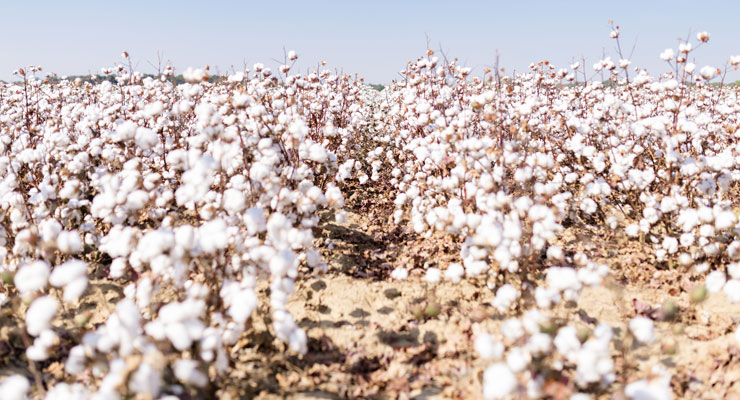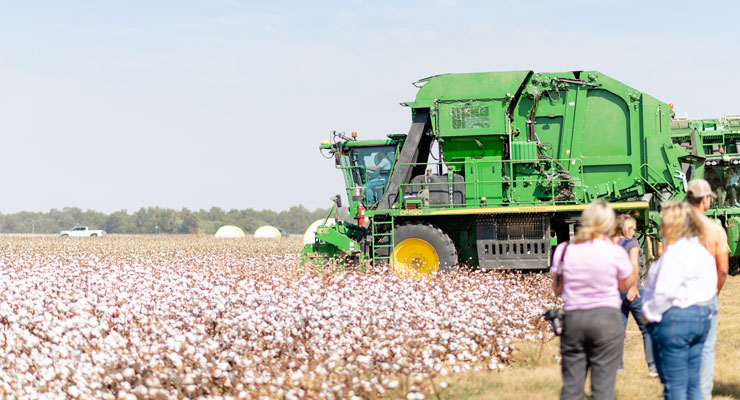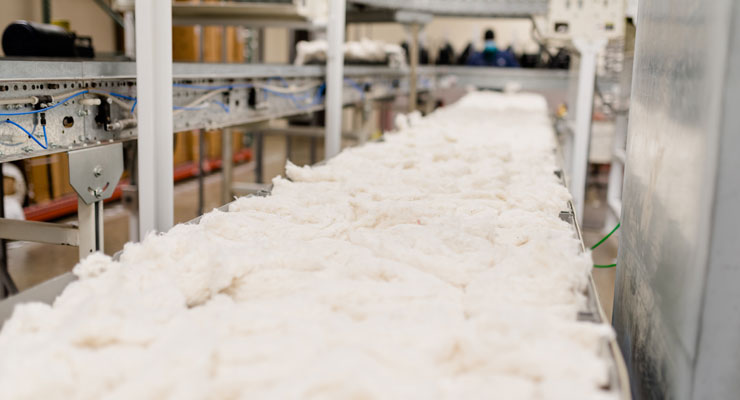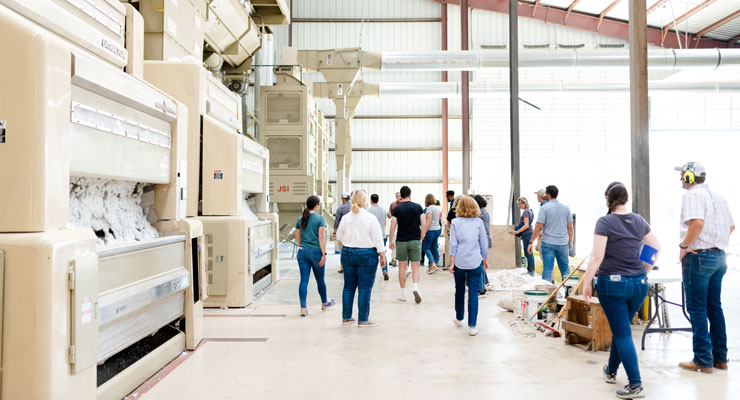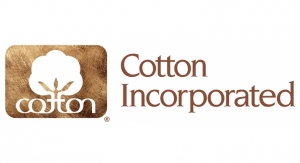2022 marked the first year back for Cotton Incorporated’s annual farm tour event after pausing during the pandemic. This unique field to factory tour gives company representatives an exclusive backstage pass to planting, growing, harvesting, ginning, classing, and warehousing before cotton is shipped to factories to be manufactured into products. Understanding cotton from the farm forward, attendees had their boots on the ground and into a cotton picker for a hands-on experience this fall.
For this year’s annual tour, Cotton Incorporated hosted two groups consisting of apparel, home, and nonwoven industry professionals. The tour focused primarily on the cotton belt’s Upland cotton production in Arkansas. Before setting foot in the field, the event kicked off day one by setting the stage for responsible cotton production and cotton sustainability. This “classroom” day included presentations from Cotton Incorporated’s experts including Mark Messura, Dr. Ed Barnes, Dr. Ryan Kurtz, Dr. Gaylon Morgan, and Steven Pires. These industry experts helped brands understand the importance for their organizations to define sustainability for their companies and end consumers. Cotton Incorporated defines sustainable agriculture as meeting the needs of the present while improving the ability of future generations to meet their own needs by:
Participants’ objectives were captured in an exercise where they wrote down questions about cotton that they sought answers to and key topics of interest. Overall, the two most asked questions centered around traceability and how brands can tell the cotton sustainability story to their end consumers at retail. The farm tour event illustrated for the attendees the capability for U.S. cotton to be traceable to the gin level. Ginners process cotton within a local region with a Permanent Bale Identification (PBI) tag that follows the cotton to the manufacturing facility.
From the classroom to the cotton field, attendees spent much of day two in cotton fields, visiting growers in Marianna, Arkansas. Farmers shared their evolving farm management practices that have contributed to the profitability of the farm and reduced the environmental footprint, enabling them to be more responsible producers by increasing yields with fewer inputs. Some examples of key farm management practices among the growers included crop rotation, cover crops, and maximizing soil health. After diving into agriculture research, the afternoon transitioned to a walkthrough of the ginning process and concluded with a warehouse tour.
On day three of the tour, the group visited the United States Department of Agriculture (USDA) classing office, a center of excellence in cotton classification. The USDA will likely process more than 13 million bales this year, with about 70 percent exported and 30 percent sold into domestic mills.1 U.S. cotton classification serves as a global model, and attendees were able to see first-hand the PBI process, high-tech automation, testing, and how cotton is classified before entering the marketplace. Cotton markets are primarily apparel (80%) and home (15%), followed by nonwovens/other uses (5%).2 This breakdown of cotton share across the markets further illustrates why the majority of U.S. cotton is sold overseas today due to its heavy use in apparel.
During this unique experience, representatives from all levels of the value chain had a chance to engage with farmers, as well as the heart of this hygiene component: cotton. As the pressures from global plastic-free regulation in disposable nonwovens evolves and end consumers drive demand for eco-friendly products, retailers seek sustainable and traceable solutions to deliver on these needs. Cotton Incorporated’s Farm Tour provides critical exposure for decision makers to evaluate cotton as a sustainable ingredient solution for their supply chain, and the tour empowers them to judge cotton sustainability themselves.
For more information on cotton as a hygiene component visit cottonworks.com/nonwovens or reach out directly to nonwovens@cottoninc.com.
Sources
1. USDA, Cotton: World Markets and Trade, October 2022
2. Smithers, The Future of Global Nonwovens to 2027
For this year’s annual tour, Cotton Incorporated hosted two groups consisting of apparel, home, and nonwoven industry professionals. The tour focused primarily on the cotton belt’s Upland cotton production in Arkansas. Before setting foot in the field, the event kicked off day one by setting the stage for responsible cotton production and cotton sustainability. This “classroom” day included presentations from Cotton Incorporated’s experts including Mark Messura, Dr. Ed Barnes, Dr. Ryan Kurtz, Dr. Gaylon Morgan, and Steven Pires. These industry experts helped brands understand the importance for their organizations to define sustainability for their companies and end consumers. Cotton Incorporated defines sustainable agriculture as meeting the needs of the present while improving the ability of future generations to meet their own needs by:
- Increasing productivity to meet future food and fiber demands
- Improving the environment
- Improving human health
- Improving the social and economic well-being of agricultural communities
Participants’ objectives were captured in an exercise where they wrote down questions about cotton that they sought answers to and key topics of interest. Overall, the two most asked questions centered around traceability and how brands can tell the cotton sustainability story to their end consumers at retail. The farm tour event illustrated for the attendees the capability for U.S. cotton to be traceable to the gin level. Ginners process cotton within a local region with a Permanent Bale Identification (PBI) tag that follows the cotton to the manufacturing facility.
From the classroom to the cotton field, attendees spent much of day two in cotton fields, visiting growers in Marianna, Arkansas. Farmers shared their evolving farm management practices that have contributed to the profitability of the farm and reduced the environmental footprint, enabling them to be more responsible producers by increasing yields with fewer inputs. Some examples of key farm management practices among the growers included crop rotation, cover crops, and maximizing soil health. After diving into agriculture research, the afternoon transitioned to a walkthrough of the ginning process and concluded with a warehouse tour.
On day three of the tour, the group visited the United States Department of Agriculture (USDA) classing office, a center of excellence in cotton classification. The USDA will likely process more than 13 million bales this year, with about 70 percent exported and 30 percent sold into domestic mills.1 U.S. cotton classification serves as a global model, and attendees were able to see first-hand the PBI process, high-tech automation, testing, and how cotton is classified before entering the marketplace. Cotton markets are primarily apparel (80%) and home (15%), followed by nonwovens/other uses (5%).2 This breakdown of cotton share across the markets further illustrates why the majority of U.S. cotton is sold overseas today due to its heavy use in apparel.
During this unique experience, representatives from all levels of the value chain had a chance to engage with farmers, as well as the heart of this hygiene component: cotton. As the pressures from global plastic-free regulation in disposable nonwovens evolves and end consumers drive demand for eco-friendly products, retailers seek sustainable and traceable solutions to deliver on these needs. Cotton Incorporated’s Farm Tour provides critical exposure for decision makers to evaluate cotton as a sustainable ingredient solution for their supply chain, and the tour empowers them to judge cotton sustainability themselves.
For more information on cotton as a hygiene component visit cottonworks.com/nonwovens or reach out directly to nonwovens@cottoninc.com.
Sources
1. USDA, Cotton: World Markets and Trade, October 2022
2. Smithers, The Future of Global Nonwovens to 2027

